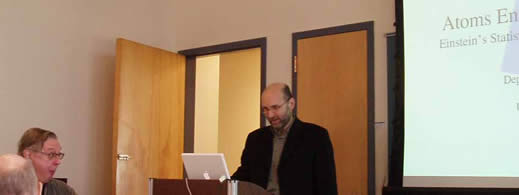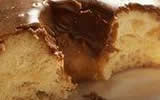Tuesday, 14 February 2006
Einstein Yadda Yadda Yadda

Tuesday, February 14th was my turn to speak in the Center's lunchtime
colloquium. Because of the hooplah surrounding the 100th anniversary
of Einstein's big year of 1905, I've done a lot of work on Einstein's
big year. Everyone knows that this was the year of special relativity
and E = mc2. And people have a vague idea of other work.
Something to do with atoms maybe. My goal was to make this "other
work" come to life, to show that something very extraordinary also
happened in this other work. Could I do this, I wondered as the
usual crowd settled into their seats, sipping their coffee and munching
on donuts and bagels. Here goes, I thought.
The end point was Einstein's proposal of the light quantum. The
idea was very simple. Sometimes light behaves as if its energy was
localized at points in space. No big deal? Well it is a big deal
if you are proposing it at a time when the greatest success of physics
was Maxwell's theory of electrodynamics in which it is shown that
light is a wave spread out in space. Given that background,
Einstein's light quantum is just a bolt from the blue.
How could Einstein come up with it? The point of my talk was that
Einstein's path to the result lay elsewhere. In the years leading
up to 1905, Einstein had proved himself to be a master of statistical
physics. When you try to analyze the physics of the many atoms that
make up a gas or a liquid, there are so many of them that precise
treatment of each atom is impossible. Instead you have to treat
them
by the methods of statistics. That work had been the focus of Einstein's
earliest papers of 1901 and 1902; and the work continued through
to another pair of his papers of 1905, his doctoral dissertation
and his "Brownian motion" paper.
You can read about the details of this work on my website. (Go to
"Goodies.")
What matters in it is that Einstein had become a master at using
the observed properties of gases and liquids to infer to their atomic
microstructure. That atomic microstructure leaves a definite fingerprint
on the observed properties of thermal systems, if only one knows
how to read it. The ideal gas law, taught to every
school child, is actually a fingerprint of many, localized independent
atoms.
This skill at reading the signs, developed over the years, was the
decisive tool Einstein needed to get to the light quantum. In poring
over the measured properties of high frequency heat radiation, Einstein
found the signature of atoms and his inference from that signature
to the granular structure of radiation forms the core section of
the his paper.
Once we see the path that Einstein followed, his proposing of the
light quantum was not a bolt from the blue, but an adventurous extension
of ideas that permeated his other work of 1905 and before.
Nonetheless Einstein's use of these statistical techniques was bold
and inspired, so much so that his colleagues in physics needed 20
years before they would accept Einstein's conclusion.
John D. Norton
John D. Norton
14 February 2006
:::
Atoms
Entropy Quanta: Einstein's Statistical Physics of 1905
:::
Lunchtime Colloquium
|


![]()
![]()
